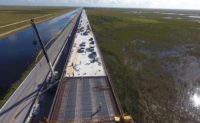A series of demonstration projects, which will complete at the end of 2016, will set the stage for a project to restore water quality in more than 300 canals in the Florida Keys, with a conceptual cost estimate of between $300 million and $600 million. The Keys has 502 canals, with a total length of 170 miles. Most of the canals were built between the 1940s and 1970s, with little thought for the attendant environmental issues. Water quality in most of the canals, measured by the levels of dissolved oxygen, has been degraded by the decomposition of organic materials in canals that are inadequately flushed to tide.
Ultimately, the goal is to make the canals “both swimmable and fishable,” says Rhonda Haag, sustainability program manager for Monroe County, which embraces the Keys. The project began about four years ago, when the Canal Management Master Plan was prepared, she says.
Amec Foster Wheeler (Amec FW) has worked with the county on canal management since 2001. “We developed a GIS database that detailed all the canals and the characteristics of the canals. [That database] became the basis for the development of the water-quality improvement program,” says Ricardo Fraxedas, Amec FW chief engineer, environment and infrastructure business. The database and visits to every canal helped Amec FW and the county to classify the canals as being either good, fair or poor to prioritize treatment and determine which canals could benefit most quickly from measures to improve water quality.
A $5-million series of demonstration projects on six “poor” canals began in 2014 and are slated for June completion. “Those were to test the different technologies—to see how well they work and how much they cost,” Haag says. For another $2 million, four more demonstration projects will be completed by the end of the year.
Completion of the remaining 295 canals has yet to be planned. “I think we’re going to look at preparing that plan and hiring an engineer to give us a better idea of the overall dollar estimate,” Haag says.
Results from the initial five demonstrations are promising. “We’ve gotten phenomenal letters from the homeowners, saying, ‘I’ve never seen the bottom of the canal’ [or] ‘There’s now fish coming into the canal.’ They’re very happy,” Fraxedas says.
Haag and Fraxedas both foresee funding as being the overall project’s biggest challenge. To supplement state and federal grants, the county is encouraging homeowners to form associations to address problems and maintenance of the cleansing systems in their local canals.


Post a comment to this article
Report Abusive Comment